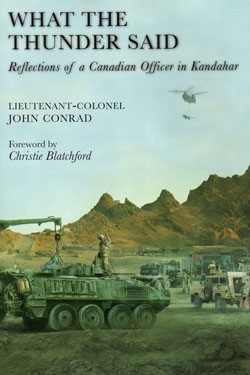 This information has been archived for reference or research purposes.
This information has been archived for reference or research purposes.
Archived Content
Information identified as archived on the Web is for reference, research or recordkeeping purposes. It has not been altered or updated after the date of archiving. Web pages that are archived on the Web are not subject to the Government of Canada Web Standards. As per the Communications Policy of the Government of Canada, you can request alternate formats on the "Contact Us" page.
Book Reviews

What the Thunder Said: Reflections of a Canadian Officer in Kandahar
reviewed by Bob Martyn
For more information on accessing this file, please visit our help page.
WHAT THE THUNDER SAID: REFLECTIONS OF A CANADIAN OFFICER IN KANDAHAR
by Lieutenant-Colonel John Conrad
Toronto: Dundurn Press, 2009
$29.95 (paperback), 239 pages
ISBN 978-1-55488-408-7
Reviewed by Bob Martyn
It is testament to Lieutenant-Colonel Conrad’s writing ability that I read this book in one sitting. While it has become a cliché that “amateurs study tactics while professionals study logistics,” very few published works on combat logistics manage to retain a reader’s attention. John Conrad, however, has succeeded brilliantly.
What the Thunder Said provides previously absent insight into the personnel and operations of Canada’s first combat logistics battalion, or National Support Element (NSE), deployed to Kandahar in 2006. Conrad commanded that battalion, and he speaks with eloquence, passion, and honesty about both its successes and failures.
He is unflinching in his indictment of the Logistics Branch’s senior leadership, noting how their neglect of tactical acumen in embracing civilian business approaches failed the soldiers carrying the weight of “the last 300 metres of the supply chain.” He attributes this to an aversion to professional reflection, which left logistics doctrine woefully out of step with contemporary combat operations. He is equally scathing in outlining the history and results of Alternate Service Delivery (ASD), and the gutting of the Brigade Groups’ Service Battalions.
Conversely, he is just as passionate in his praise for the soldiers within his command. After setting the stage with a view of the mission, supporting Lieutenant-Colonel Ian Hope’s 1PPCLI Task Force Orion, Conrad dedicates a chapter each to the main sub-components within the NSE. These provide more than simply a description of the supply function or the maintainers’ routine, but also enlightening insight into the daily challenges inherent in supporting operations in remote locations. One of the methods used to illustrate the human costs and soldiers’ innovative solutions is to introduce readers to various individuals and let their stories carry the narrative. It is Conrad’s expressiveness, through this writing device, that truly brings the story to life. It is the soldiers’ ‘can-do’ attitude and stoic determination that made the sustainment effort a success; a “…very near run thing: a brush with failure that was all too close.”
In telling the logistics story through his soldiers, broaching the reality of combat deaths and injuries is inevitable. Explaining the multiplicity of tasks – medical evacuations, vehicle recovery, and repatriation of the deceased – Conrad also shares with us the emotions of losing troops under his command. I confess that this portion of the book was particularly difficult for me, it having rekindled personal Afghanistan memories. Yet, I thank him for bringing this darker aspect to the public’s attention.
The book is well laid out. Conrad makes excellent use of endnotes to provide further details, or to provide citations to other source material. The index is thorough, and the foreword by Christie Blatchford sets the tone nicely. If I had any criticism of the work, it would be Conrad’s perhaps excessive use of superlatives: “…the magnificent 2nd Battalion in Shilo,” “Canada’s fabled Army of the West,” or “Canada’s superb Command and Staff College.” This complaint, however, would be pedantic, and is but a very minor irritant when considering the substantive content, which is above reproach.
In all, Lieutenant-Colonel Conrad has produced an excellent book, which contributes to a seriously neglected aspect of warfighting. Perhaps this is changing. As he notes “…it has been a long time since logistics mattered to the extent that it does in combat. Fighting in far away places where you need medical evacuation and you can actually run out of diesel has a way of increasing interest in neglected corners.”
As a soldier and an academic, I thank Lieutenant-Colonel Conrad for shining some light into those corners, as well as for sharing some of his personal war with us. “Za canadai askar yam.”
![]()
Doctor Robert B. Martyn is an Adjunct Professor of Military and Security History at Queen’s University. He is also a serving officer in the Army Reserve.






